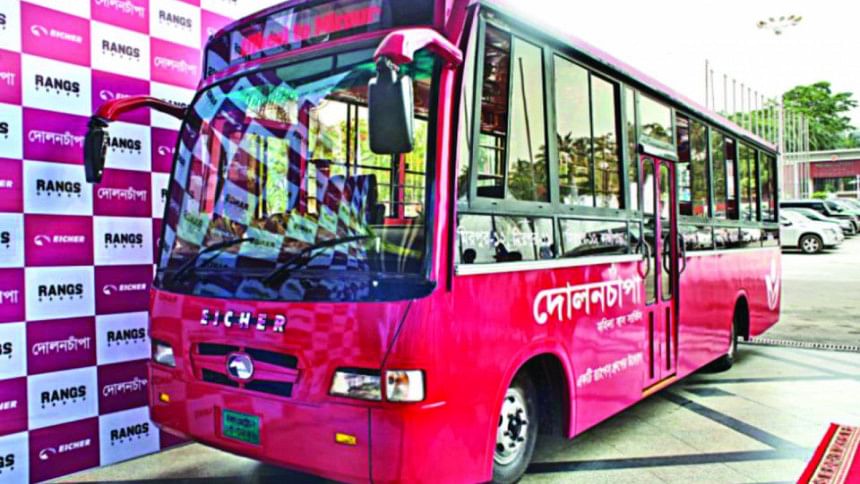Women-only bus is not the solution

Early in June this year, a women-only bus service named Dolonchapa was launched by Rangs Group in Dhaka with a view to giving women a "safer" and "easier" travel option (The Daily Star). This initiative came against the backdrop of rampant sexual harassment of women in public transport. A recent BRAC study found that 94 percent of women in Bangladesh face sexual harassment when commuting by public transport. The study identified three major causes of such sexual harassment: lax implementation of laws, overcrowding in buses and lack or absence of monitoring (such as through closed-circuit cameras).
Owing to such prevalent sexual harassment of women in public transport, this private initiative—the first of its kind in Bangladesh—promises to address the growing need for "safe public transportation for women". As such, it has been recognised by the stakeholders and commentators as a sort of victory for the women commuters of Dhaka and a milestone in the fight against sexual harassment. Undoubtedly this comes as a necessary reprieve for the countless women who are tired of facing sexual harassment in their daily lives. But let us be clear here: this is by no means a step forward in the battle against sexual harassment nor is it a feasible solution since it does not address (much less resolve) the underlying cause of the problem to begin with.
Firstly, measures such as the introduction of women-only buses target women, the victims of sexual harassment, and seek to change how they conduct their lives, rather than focusing on men, the perpetrators of sexual harassment, and preventing them from committing the act in the first place. This is because the sex segregation model of fighting harassment posits that it is women who have to take themselves out of the spaces shared by men or risk suffering the consequences. Therefore, it places the onus on women to "avoid getting sexually harassed" while granting impunity to the actual sexual harassers. Thereby, it treats sexual harassment as an inevitable social menace that women must circumvent rather than something that men could be taught not to do.
Secondly, it does not actually make women safer. Sure, it may "prevent" individual cases of sexual harassment for a small number of women "lucky" enough to avail themselves of such services, either because they can afford to pay the higher price or because the buses just so happen to cover their required route. But the fact remains that such services will simply not reach the vast majority of women commuters and that it leaves untouched the very root of the problem. By focusing on women's conduct instead of addressing lewd male behaviour, the sex segregation model of fighting harassment only works to embolden the harassers and worsen the problem in areas where such segregation does not exist, considering the fact that we cannot feasibly hope to ensure gender segregation in all aspects of public life (nor should we).
For instance, if a woman travelling by an ordinary bus complains about being sexually harassed, the introduction of women-only bus services allows the harassers to respond by saying, for example, "if you don't like it here, why don't you travel by a women-only bus?"
Thirdly, and perhaps less obviously, such private initiatives, in a sense, commodify female trauma and evince that ostensibly "social welfare" initiatives can be quite profitable private ventures themselves. A handful of women I surveyed, who regularly use public transport, responded that they would be willing to pay three to four times the amount of a regular bus fare if it meant that they could have a sexual harassment free experience. This is precisely where the trouble lies: why are these women willing to pay three to four times the regular fare for essentially the same service (i.e. a trip from Point A to Point B)? This is because something as fundamental as a woman's right to be free from sexual harassment has in reality become a market-priced luxury that can be packaged and sold to a certain class of women who can afford to pay the price. Women whose socioeconomic backgrounds do not afford them the opportunity to purchase this luxury will simply have to make do with what they can afford.
What is further regrettable is the fact that even the one scope of women's empowerment available in such initiatives was left unused because the drivers of these female buses will be male. At least in Egypt, when they introduced women-only bus services, it had a modicum of empowerment as even the bus drivers would be female. This is important because employing women in areas which are traditionally male-dominated goes a long way in challenging deep-seated misogyny and works to change our perceptions of women's role in public life.
For these reasons, I cannot stress enough that the introduction of women-only buses does not solve the sexual harassment epidemic. If anything, it only serves to normalise it. It does not empower women, rather it commodifies their trauma and capitalises on it. Therefore, this is not a success story—this is an admission of defeat; an admission of the fact that we as a society have failed to teach men that women have a right to travel in buses without being sexually harassed. It adheres to the overarching social dictate that "boys will be boys", so if women want the luxury of commuting without being sexually harassed, then it is they who should take themselves out of ordinary buses and travel by a special kind of bus instead.
Let us open our eyes to the reality that such feel-good initiatives create the illusion of problem-solving without actually even addressing the problem. Therefore, our acceptance of such initiatives should be conditional upon their being recognised and implemented as temporary band-aid solutions while the actual, long-term solutions are also underway.
Taqbir Huda is a Research Specialist at Bangladesh Legal Aid and Services Trust (BLAST) and can be reached at [email protected]

 For all latest news, follow The Daily Star's Google News channel.
For all latest news, follow The Daily Star's Google News channel. 



Comments